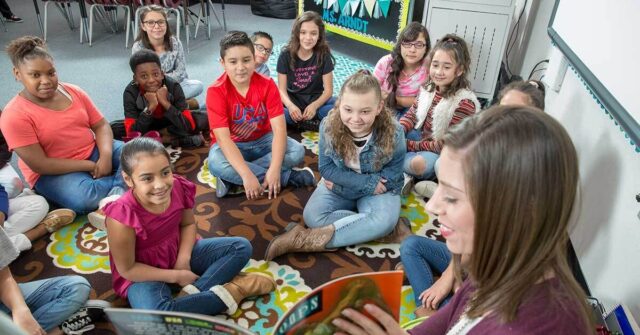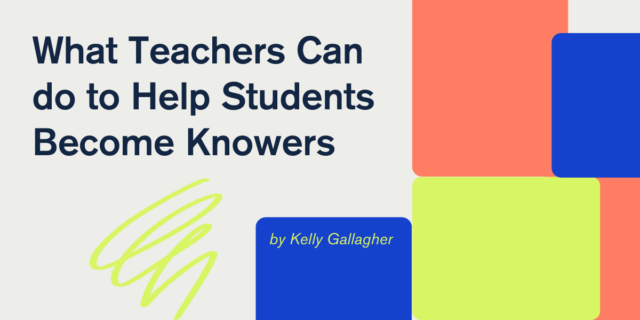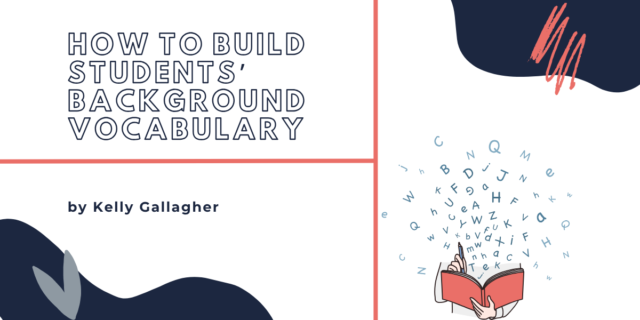
The following is an adapted excerpt from Kelly Gallagher’s To Read Stuff You Have to Know Stuff.
Years ago, I was invited to participate in a book club discussion centered on Ana Castillo’s So Far from God, a dazzling, multigenerational family saga. The meeting was held on the campus of UCLA, and there were going to be some prominent educators there, as well as the author herself. As a relatively new and unknown teacher, I was excited to be invited.
I arrived prepared. Well, overly prepared. I had flooded my copy of the novel with sticky notes, and when I walked into the room, I took my place at one of the thirty seats in a circle. My strategy was simple: I was going to let the conversation start to flow and then I was going to find just the right moment to interject a comment so brilliant that people would stop in their tracks and wonder, Wow! Who is this guy?
It wasn’t long after the conversation started, however, that I started to feel uneasy. The novel centers on Sofia, a Chicana, and her four daughters, and the conversation began by discussing several cultural references that I did not fully grasp. Strike one! (I looked around the circle of mostly Latinx participants and noticed I was one of a few Anglos as well as the only male.) The conversation then shifted to recognizing the nuances of the Spanish sprinkled throughout the novel, which went right over my head. Strike two! This was followed by a long conversation around the influence that Catholicism played in the development of the characters, and despite having the name Kelly Gallagher, I am not a Catholic and, thus, understood very little of the discussion. Strike three! Fortunately, I was wise enough to keep my mouth closed and simply listen to the wisdom in that room. In baseball terms, I was caught looking without ever swinging the bat!
I understood the book, but I did not understand the book. What was missing? Lots of prior knowledge.
How to Help Students Build Prior Knowledge Through Reading Books
Since books are the richest source in building prior knowledge, let’s look at several moves teachers can make to enrich the reading experience.
- Restructure the Teaching of the Whole-Class Novel. The value of possessing important prior knowledge has ramifications for how we structure our novel units. Think about the hardest book you teach—the one that keeps you up at night before the unit starts. I would surmise that one of the reasons that particular book is difficult for students is because it is far away from their prior knowledge. Deciding when, where, and how much you should support your readers—or whether you should support them at all—is where the art of teaching resides.
- Teach Readers to be Comfortable with Ambiguity. Many inexperienced readers do not know that confusion is normal. They get discouraged very easily if they don’t understand everything at the outset. They have not developed the ability to live with ambiguity. To rectify this, I asked students to read only the first page in a novel and to list all the things that confused them. As they progressed through the novel, they periodically returned to their lists of confusion. As they got deeper into the novel, they could see that their early confusion had cleared.
- Teach Students How to Retain Knowledge. It’s one thing to understand what you are reading. It is another thing to remember what you are reading. One way to retain what you read is to write about it. Instead of having them stop after every chapter to answer my questions, I required them to read much longer chunks before sitting down to capture their thinking. Instead of meeting them after fifteen pages, I met them after eighty-five pages, and I did not await them with a bunch of teacher-generated questions. Instead, I asked them, “You have read a significant chunk of this novel—what is worth thinking about thus far?” The writing I asked them to do was not task oriented. It was generative. I did not want them trying to spit out answers they thought would appease me. I wanted them to move away from extraction reading and to move toward the kind of writing that would help them discover their own thinking. And if they captured this thinking in writing, they’d be more likely to retain it.
- Encourage Students to Get into Other Reading Lanes. Diverse books expose readers to diverse words, and books often present these words in richer contexts than shorter reading experiences. But there are other, equally important reasons we want students to branch out. Maryanne Wolf, cognitive neuroscientist notes, “The act of taking on the perspective and feelings of others is one of the most profound, insufficiently heralded contributions of the deep-reading processes” (2019, 42). Books, she adds, give us “the capacity to communicate and to feel with another without moving an inch” (2019, 43). This is no small goal for students coming of age in a deeply divisive and fragmented time.
- Teach Students That Some Hard Books are Easy, and Some Easy Books are Hard. Hand me a book about the Vietnam War, and I will have little trouble as I have already read extensively on the subject. Hand me a book on how automotive wiring and electrical systems work, and I will immediately exhibit the same reading avoidance strategies employed by nonreaders. I am a reader, but I do not have a reading level. I have several of them. If that is true for me, it is true for my students as well. Every student has several reading levels. We are all strong readers and we are all weak readers—it depends on what we are reading. Wrestling with hard reading in front of my students reinforces the idea that we never stop learning to read.
- Teach Students That Understanding a Genre Helps You Read and Write in That Genre. Understanding how any genre works is a critical reading skill. Understanding how
essays, articles, and novels are constructed is the kind of prior knowledge that helps make the writing understandable. When students are reading a piece, have them collaboratively investigate the specific hallmarks of that genre. Ask them: “What did the writer do here? What did the writer do there?”
The building of prior knowledge is central to positioning students to be able to thoughtfully read sentences, passages, articles, and ultimately books. Hopefully, lots of books.
***



